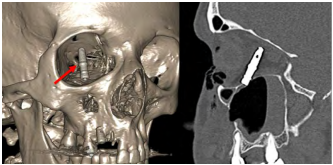Recently, numerous case reports have been published concerning displacement (at the time of surgery) or migration (after surgery or prosthetic treatment) of implants into an adjacent spaces such as the maxillary sinus1 , ethmoid sinus2 , sphenoid sinus3 , frontal sinus4 , orbit5 , nasal cavity6 , infratemporal fossa7 and the anterior cranial base8 .
ETIOLOGY – The majority of migrating dental implants originate in the maxillary sinus, then, if not removed, may migrate to adjacent spaces. The timing of implant displacement into the maxillary sinus proper has been shown to range from the time of surgery (implant insertion) to many years after prosthetic rehabilitation. When implants are found to have been displaced into the maxillary sinus, immediate evaluation and removal should be completed. If left untreated, the implants may become calcified (antrolith), initiate physiologic complications in the maxillary sinus or migrate into adjacent anatomic areas. If the implant migrates through the maxillary ostium, it may be transported through normal physiologic pathways in the paranasal sinuses and surrounding anatomic structures.
PREVENTION – To prevent displacement and migration of implants into the maxillary sinus, ideal treatment planning along with surgical technique (osseodensification) should be adhered to. A comprehensive preoperative evaluation of the posterior maxilla should be completed to determine the amount of available bone below the sinus floor. Because the primary stability of dental implants is dependent on the amount of cortical bone present, implant placement into the posterior maxilla is very susceptible to displacement. The Misch sinus augmentation (SA-1 through SA-4) classification, which is dictated on the amount of available bone present, should be strictly adhered to. In the literature, additional etiologic factors include a change in intranasal pressure, periimplantitis, and occlusal overloading.
TREATMENT – Treatment of migrated or displaced implants includes the immediate removal, which usually necessitates referral to an oral and maxillofacial surgeon (OMFS) or otolaryngologist (ENT). The most common approaches for removal of implants include the traditional Caldwell-Luc procedure, intraoral approach, or a transnasal approach with functional endoscopic sinus surgery.
CASE REPORT – A recent case report was published in the British Journal of Oral and Maxillofacial Surgery concerning a displaced implant. A 55-year-old woman was referred by her dentist to the hospital for evaluation of an implant that displaced into the maxillary sinus. During implant insertion, because of poor bone quality and quantity, the implant was accidentally displaced into the maxillary sinus. At the hospital, a computed tomographic (CT) scan revealed that the implant had migrated approximately 2 cm into the intraconal compartment of the right orbit. It was found to be located in contact with the optic nerve and adjacent to numerous intraorbital vessels. The implant was successfully removed via an enlarged endoscopic medial maxillectomy.9 (See Images Above)
- Kluppel LE ,Santos SE ,Olate S, et al:Implant migration into maxillary sinus: description of two asymptomatic cases. Oral Maxillofac Surg 14: 63 – 66, 2010 .
- Haben CM , Balys R , Frenkiel S : Dental implant migration into the ethmoid sinus . J Otolaryngol 32 : 342 – 344 , 2003 .
- Felisati G , Lozza P , Chiapasco M , Borloni R : Endoscopic removal of an unusual foreign body in the sphenoid sinus: an oral implant . Clin Oral Implants Res 18 : 776 – 780 , 2007 .
- Chiapasco M , Felisati G, et al : The management of complications following displacement of oral implants in the paranasal sinuses: a multicenter clinical report and proposed treatment protocols . Int J Oral Maxillofac Surg 38 : 1273 – 1278 ,2009 .
5.. Griffa A , Viterbo S , Boffano P : Endoscopic-assisted removal of an intraorbital dislocated dental implant . Clin Oral Implants Res 21 : 778 – 780 , 2010 .
- Li, Shichang, Zhimin Xing, and Lisheng Yu. “Accidental migration of a dental implant into the nasal cavity.” Journal of International Medical Research 48.8 (2020):
- Nocini, Pier Francesco, et al. “A dental implant in the infratemporal fossa: case report.” International Journal of Oral & Maxillofacial Implants 28.4 (2013).
- Cascone P , Ungari C , Filiaci F , et al : A dental implant in theanterior cranial fossae . Int J Oral Maxillofac Surg 39 ( 1 ): 92 – 93 , 2010 .
- Bocchialini, G., Negrini, S., Bolzoni Villaret, A., & Pianta, L. (2020). Intraconal orbital displacement of a dental implant treated with an endoscopically-assisted approach. British Journal of Oral and Maxillofacial Surgery. doi:10.1016/j.bjoms.2020.01.006
